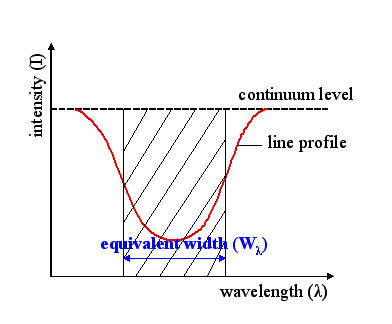|
Curve Of Growth
In astronomy, the curve of growth describes the equivalent width of a spectral line as a function of the column density The area density (also known as areal density, surface density, superficial density, areic density, mass thickness, column density, or density thickness) of a two-dimensional object is calculated as the mass per unit area. The SI derived unit is ... of the material from which the spectral line is observed. References {{astronomy-stub Spectroscopy ... [...More Info...] [...Related Items...] OR: [Wikipedia] [Google] [Baidu] |
Astronomy
Astronomy () is a natural science that studies astronomical object, celestial objects and phenomena. It uses mathematics, physics, and chemistry in order to explain their origin and chronology of the Universe, evolution. Objects of interest include planets, natural satellite, moons, stars, nebulae, galaxy, galaxies, and comets. Relevant phenomena include supernova explosions, gamma ray bursts, quasars, blazars, pulsars, and cosmic microwave background radiation. More generally, astronomy studies everything that originates beyond atmosphere of Earth, Earth's atmosphere. Cosmology is a branch of astronomy that studies the universe as a whole. Astronomy is one of the oldest natural sciences. The early civilizations in recorded history made methodical observations of the night sky. These include the Babylonian astronomy, Babylonians, Greek astronomy, Greeks, Indian astronomy, Indians, Egyptian astronomy, Egyptians, Chinese astronomy, Chinese, Maya civilization, Maya, and many anc ... [...More Info...] [...Related Items...] OR: [Wikipedia] [Google] [Baidu] |
Equivalent Width
The equivalent width of a spectral line is a measure of the area of the line on a plot of intensity versus wavelength in relation to underlying continuum level. It is found by forming a rectangle with a height equal to that of continuum emission, and finding the width such that the area of the rectangle is equal to the area in the spectral line. It is a measure of the strength of spectral features that is primarily used in astronomy. Definition Formally, the equivalent width is given by the equation W_\lambda = \int d\lambda = \int (1 - F_s / F_c) d\lambda. Here, F_c(\lambda) represents the underlying continuum intensity, while F_s(\lambda) represents the intensity of the actual spectrum (the line and continuum). Then W_\lambda represents the width of a hypothetical line which drops to an intensity of zero and has the "same integrated flux deficit from the continuum as the true one." This equation can be applied to either emission or absorption, but when applied to emission, t ... [...More Info...] [...Related Items...] OR: [Wikipedia] [Google] [Baidu] |
Spectral Line
A spectral line is a dark or bright line in an otherwise uniform and continuous spectrum, resulting from emission or absorption of light in a narrow frequency range, compared with the nearby frequencies. Spectral lines are often used to identify atoms and molecules. These "fingerprints" can be compared to the previously collected ones of atoms and molecules, and are thus used to identify the atomic and molecular components of stars and planets, which would otherwise be impossible. Types of line spectra Spectral lines are the result of interaction between a quantum system (usually atoms, but sometimes molecules or atomic nuclei) and a single photon. When a photon has about the right amount of energy (which is connected to its frequency) to allow a change in the energy state of the system (in the case of an atom this is usually an electron changing orbitals), the photon is absorbed. Then the energy will be spontaneously re-emitted, either as one photon at the same frequenc ... [...More Info...] [...Related Items...] OR: [Wikipedia] [Google] [Baidu] |
Column Density
The area density (also known as areal density, surface density, superficial density, areic density, mass thickness, column density, or density thickness) of a two-dimensional object is calculated as the mass per unit area. The SI derived unit is the kilogram per square metre (kg·m−2). A related '' area number density'' can be defined by replacing mass in by number of particles or other countable quantity. In the paper and fabric industries, it is called grammage and is expressed in grams per square meter (g/m2); for paper in particular, it may be expressed as pounds per ream of standard sizes ("basis ream"). Formulation Area density can be calculated as: \rho_A = \frac or \rho_A = \rho \cdot l where, Column density A special type of area density is called ''column (mass) density'' (also ''columnar mass density''), denoted ''ρ''A or ''σ''. It is the mass of substance per unit area integrated along a path; It is obtained integrating volumetric density \rho ov ... [...More Info...] [...Related Items...] OR: [Wikipedia] [Google] [Baidu] |

